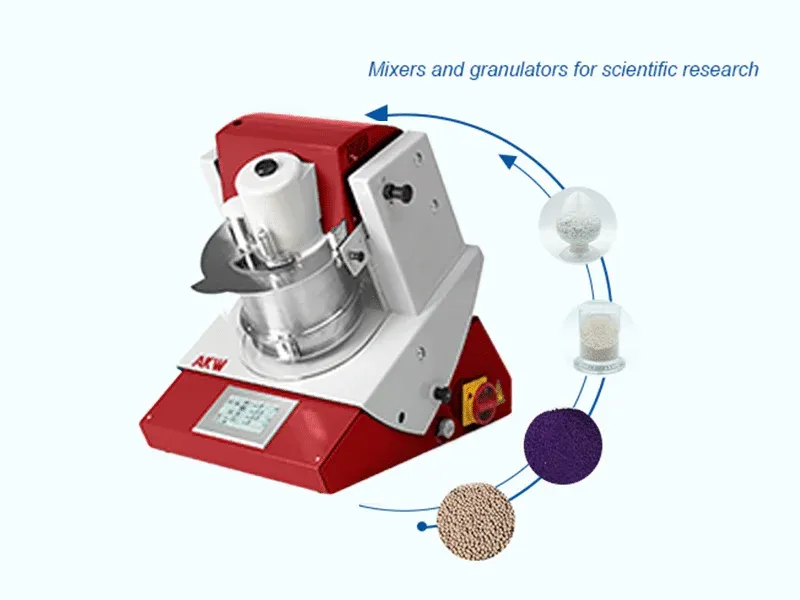Countercurrent mixing and shear mixing: the material rotates upward continuously under the action of the inclined mixing disk, and after reaching a certain height, it falls vertically under the action of gravity to achieve rough mixing. After entering the mixing range of the high-speed rotor, high-intensity mixing movement is carried out to achieve high-precision mixing.
Combination of mechanical mechanics and fluid mechanics: such as the Sakomi inclined mixing granulator, through the unique inclined working chamber design, promotes the all-round flow and mixing of materials. Under the precise control of the inclined angle, the materials are evenly distributed and subjected to continuous and stable shear force, extrusion force and friction force, realizing the uniform transformation from powder to granules.

Mixing disk: usually inclined design, so that the material rises and falls continuously during the rotation process to achieve preliminary mixing.
High-speed rotor: located inside the mixing disk, rotating at high speed, generating strong shear and mixing effects, ensuring high-precision mixing of materials.
Multi-function scraper: fixed position, used to disrupt the flow direction of materials, transport them to the mixing range of the high-speed rotor, and prevent material adhesion.
Drive system: provides power for the mixing disk and high-speed rotor so that they can rotate normally.
Control system: used to adjust the rotation speed of the mixing disk and high-speed rotor, as well as to control the operation of the entire equipment, and can also achieve precise control of parameters such as material flow and granulation time.
Excellent mixing performance: can quickly and evenly mix the catalyst raw materials to avoid local concentrations that are too high or too low, ensure that the active components of the catalyst are evenly distributed, and improve the overall performance of the catalyst.
Precise granulation: can accurately control the size, shape and density of granulation to meet the specific requirements of different catalytic reactions for the morphology of catalyst particles, and produce catalyst particles with uniform particle size and regular shape, which is conducive to the distribution and fluidization of the catalyst in the reactor and improves the reaction efficiency.
High production efficiency: can complete the mixing and granulation tasks of a large number of catalysts in a short time, greatly improve production efficiency, and meet the rapid market demand for catalysts.
Adjustable parameters: speed, inclination angle, material flow, granulation time and other parameters can be adjusted according to material characteristics and process requirements to optimize the mixing and granulation effects and adapt to the production requirements of different catalysts.
Strong stability and reliability: after careful design and rigorous testing, it can maintain stable performance during long-term operation, reducing the maintenance cost of the enterprise and improving production efficiency.
Energy saving and environmental protection: low-energy motors and optimized process flow are used to reduce energy consumption and exhaust emissions. At the same time, advanced dust removal systems are equipped to ensure that dust in the production process is effectively controlled.
Chemical industry: used to prepare catalysts required for various chemical reactions, such as hydrogenation catalysts and oxidation catalysts in petrochemicals, esterification catalysts and polymerization catalysts in organic synthesis, etc.
Petrochemical field: can be used to improve the catalytic efficiency in the process of petroleum processing, such as catalyst preparation in catalytic cracking, catalytic reforming, hydrofining and other processes.
Environmental protection field: used to prepare environmentally friendly catalysts required for the treatment of waste gas, wastewater, etc., such as three-way catalysts for automobile exhaust purification, catalysts for treating nitrogen oxides and sulfur dioxide in industrial waste gas, and catalysts for treating organic matter in wastewater, etc.
New energy industry: also has important applications in the preparation of new energy materials, such as for the preparation of lithium-ion battery positive electrode materials, fuel cell catalysts, etc.